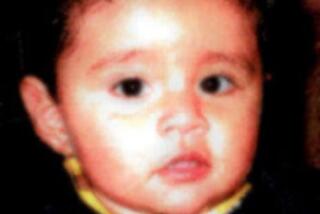Updating Tools to Seek Lost Children : Search Groups Move From Milk Cartons to Computer Kiosks
It has been 12 years since 3-year-old Laura Bradbury of Huntington Beach vanished during a family camping trip at Joshua Tree National Monument, sparking a nationwide search and a change in the way the police and public view missing children.
The Bradbury case and several other highly publicized child abductions in the early 1980s heightened awareness and spawned an unprecedented campaign to place the pictures of missing children on billboards, shopping bags and milk cartons.
In recent years, however, organizations that help find missing children have shifted their strategy, focusing less on milk-carton mug shots and more on technology and advanced graphics.
âComputer technology allows us to disseminate information very quickly,â said Kathy DePeri, executive director of the Orange County division of the National Center for Missing and Exploited Children.
âThe time element is so important. Those first 24 hours are crucial,â DePeri said. âIt can save a childâs life.â
The new tactics are also aimed at addressing criticism that constant exposure to photos of missing youngsters on billboards and milk cartons frightens young children and causes undue community panic.
âWe work very hard to put the issue in perspective and not to prey on fear . . . especially in the minds of children when they see these images at the breakfast table,â said Ernie Allen, president of the National Center, which stopped using milk cartons several years ago.
âWe still want to display the photos for the public to see, but in a positive way, not a frightening one,â Allen said.
*
Orange County officials and organizations are taking the lead in the new approach. During the summer, John Wayne Airport put up a computerized kiosk, one of only 20 in the nation, that displays pictures of missing children and provides safety tips to travelers.
Half a dozen of the children featured at the kiosks have been found, officials said.
Meanwhile, state Sen. Ross Johnson (R-Irvine) pushed through legislation this year creating a World Wide Web site that will display pictures and perhaps even videos of abducted children. The site will go online early next year.
Law enforcement and child services experts say that new technology lets them distribute photos just hours after abduction cases are reported, and state-of-the-art graphics enable them to âageâ children who vanished years ago.
The speed of computer networking is a big advantage over printing photos on milk cartons, which usually take weeks to produce and distribute.
After her 1984 disappearance, Laura Bradburyâs photo appeared on millions of fliers, T-shirts and billboards across Orange County and around the world. Thousands of volunteers searched for her in the desert, but their efforts failed. Two years later, hikers stumbled across what would later be identified as her remains.
Since then, missing childrenâs groups have worked to develop ways of distributing information about missing children quickly to as many people as possible without causing unwarranted fear or anxiety.
Many experts now acknowledge that billboard and milk-carton campaigns proved to be simplistic and ineffective.
*
Besides relying more on technology, groups are also focusing attention on educating children and parents about abduction-prevention techniques.
âThere has been a change from simply âstranger dangerâ to empowering kids to protect themselves,â said Orange County Supervisor William G. Steiner, a child welfare expert.
âWe donât want to get peopleâs attention through hysteria or sensationalism,â Steiner said. âBut by the same token, we recognize the importance of reaching people and that the media can be a very powerful tool.â
Steiner, who is on the National Centerâs board of directors, was instrumental in bringing the computer kiosk to John Wayne Airport. A second kiosk will be added next year, one of 500 being installed across the nation by the center and the Pizza Hut restaurant chain.
Since late July, more than 3,000 people have scrolled through the Orange County kioskâs database, which includes photos of missing children, biographical information and safety tips.
The National Centerâs Allen said the computer network âovercomes the barrier of timeâ by allowing officials to download new photos as soon as they are available and to target distribution to specific regions.
In August, the center was preparing to place a photo of missing 2-year-old C.T. Turner on the network when the Mission Viejo boyâs body was discovered near his home a day and a half after his disappearance.
âTime is the enemy,â Allen said.
âEvery day a child is missing, the likelihood for recovery is less and less.â
More to Read
Sign up for Essential California
The most important California stories and recommendations in your inbox every morning.
You may occasionally receive promotional content from the Los Angeles Times.











